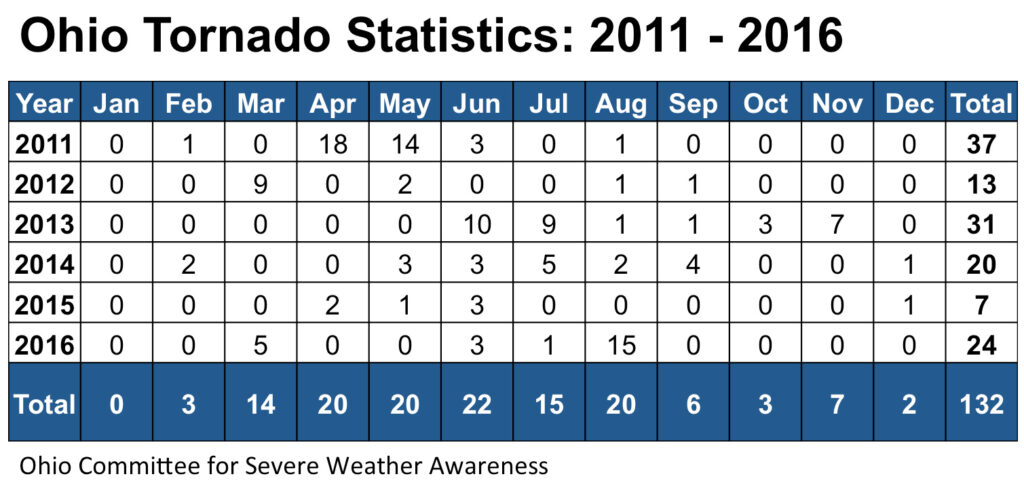Tornadoes are nature’s most violent storms, with winds reaching up to 300 miles per hour and damage paths in excess of one mile wide and 50 miles long. No home can withstand one.
Peak tornado season in Ohio is generally April through July, but tornadoes can and have occurred at any time, during any season. In 2016, there were 24 confirmed tornadoes in Ohio, with 11 occurring in one day. August 24th was deemed a Tornado Outbreak, with a total of 22 confirmed tornadoes across Indiana and Ohio (11 each). Fortunately, there were no fatalities and only one reported minor injury. No other tornadoes developed in Ohio for the rest of the year.

Tornado Home Coverage and Preparedness Tips
We’ve all heard the expression: “An ounce of prevention is worth a pound of cure.” And it’s just as true for disaster preparedness as it is for your personal health. While we can’t prevent weather events—such as tornadoes—from happening, we can prepare in case one strikes.
- Tornado losses are most often covered by the “windstorm peril” under the homeowner’s insurance policy.
- Check with your homeowner insurance agency to assure adequate coverage is provided by the policy. Notify the insurance agency of any additions or improvements to the home.
- Consider purchasing the replacement cost coverage endorsement for the home and its contents. It would give the option to rebuild or replace damaged property at current costs rather than depreciated values.
- If you experience a storm-related loss to your home that is covered by your insurance, notify your insurer in a timely manner, as required by your policy.
Contact your McCutcheon Insurance Agent to make sure your covered in the event of a loss from a tornado.
Tornadoes can also develop quickly with little to no warning, so we’ve compiled these tips to make sure you’re covered and help you get ready before the storm hits.
Home Inventories Assist in Settling Claims
- Videotape, photograph or compile a written inventory of your home and belongings.
- Keep the inventory off premises in a bank safe deposit box. The inventory will provide a record for you and the insurance company, should a loss occur.
- Update your inventory every time you move or every two to three years.
Written Inventory Tips
- Go through each room of the home and list every item. Include the purchase date, price and model numbers.
- Include professional, written appraisals of antiques, jewelry and other costly possessions.
- Click here to to download Ohio Insurance Institute’s Personal Property Inventory Form.
Video or Photo Inventory Tips
- Pan the camera around the room to capture all items. Obtain close-ups of expensive items such as jewelry, china and furs.
- Consider grouping items for easier inventory.
- Narrate the video by noting purchase costs and dates. Include model and serial numbers for appliances and electronic devices.
Auto Coverage and Preparedness Tips
- If there is threatening weather, shelter vehicles to prevent damage from winds, flying debris and hail.
- Vehicles are protected under the “other than collision” (comprehensive) portion of an auto insurance policy, if damaged by windstorms or hail.
After the Loss – Insurance Tips
- Photograph any damage and inventory losses. Photos will assist when settling claims.
- Secure property from further damage or theft and save related receipts, since many insurers will reimburse for these expenses.
- If required to seek temporary housing due to a covered loss such as a tornado, check your policy for “loss of use” coverage. Many policies cover such expenses up to a stated amount.
What to do during the storm
Familiarize yourself with the different terms that identify a storm or a tornado risk:
- A Watch—A severe thunderstorm or tornado is possible. Remain alert for approaching storms. Watch the sky and listen to a radio or television for more information.
- A Warning—A severe thunderstorm or tornado has been sighted or indicated by a weather radar. You should take shelter immediately.
If you happen to be placed under a storm warning, keep yourself as safe as possible and remember these steps:
- Seek shelter immediately in your designated safe place.
- Get under a sturdy table and use your arms to protect your head and neck.
- Don’t open your windows. It was once thought that this would help, but it actually will put you at risk of injury from breaking glass.
If you are unable to seek shelter:
- Take cover in a stationary vehicle. Put the seat belt on and cover your head with your arms and a blanket, coat or other cushion if possible.
- Do not get under an overpass or bridge. You are safer in a low, flat location.
- Never try to outrun a tornado in urban or congested areas in a car or truck.
Unfortunately, tornados are a natural disaster for which Ohioans must prepare and experiencing one can be devastating. Stay safe and don’t be caught off guard.
Please contact McCutcheon Insurance at (330) 929-2546 for complete details on coverages and discounts. If the policy coverage descriptions in this article conflict with the language in your policy, the language in your policy applies.










